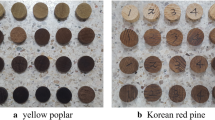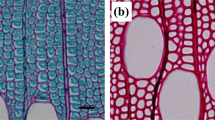Abstract
Hygroscopic properties and water vapour permeability of chestnut (Castanea sativa Mill.) wood were studied using saturated salt solutions, and the results were analyzed using the Hailwood–Horrobin model. At 20 °C/65 % the equilibrium moisture content (MC eq ) and density were 11.5 ± 0.1 % and 576.6 ± 10.2 kg m−3, respectively, and the fiber saturation point was 20.83 %. The average water vapour permeability was 0.320 kg m−1 s−1 Pa−1108, lower than that of Radiata pine (0.726 kg m−1 s−1 Pa−1108). Furthermore, there was no difference in permeability between tangential and radial cuts. This low permeability is explained by the scant development of the multilayer of the Hailwood–Horrobin model. This is attributed to the wood extractives, which reduce the void space and hindered condensation. Chestnut wood has different vapour sorption and vapour permeability than conifers normally used in construction.

Similar content being viewed by others
References
Hailwood AJ, Horrobin S (1946) Absorption of water by polymers: analysis in terms of a simple model. Trans Faraday Soc 42(B):84–102
Militz H, Busetto D, Hapla F (2003) Investigation on natural durability and sorption properties of Italian Chestnut (Castanea sativa Mill.) from coppice stands. Holz Roh Werkst 61:133–141
Nocetti M (2010) Machine grading of Italian structural timber: preliminary results on different wood species. World Conference on Timber Engineering, Trentino, Italy
Skaar C (1988) Wood–water relations. Springer, Berlin, p 283
UNE-EN ISO 12572 (2002) Hygrothermal performance of building materials and products. Determination of water vapour transmission properties. (ISO 12572:2001). AENOR. Madrid, p 34
UNE-EN 1912 (2005) Structural timber. Strength classes. Assignment of visual grades and species. AENOR. Madrid. UNE-EN 1912:2005 + A4, p 22
Wagenführ R (1988) Holzeigenschaftstafel. Holztechnologie 29(3):161–162
Acknowledgments
The authors would like to thank the Ministry of Science and Innovation of Spain (MICIN) and the Plan for Science, Technology and Innovation of the Principality of Asturias (PCTI) for supporting this research through the research project “Forest and industrial valorisation of Spanish chestnut” (VALOCAS) and its funding through the Singular Strategic Projects (MICIN) and Complementary Support for Singular Strategic Projects carried out in Asturias (PCTI).
Author information
Authors and Affiliations
Corresponding author
Rights and permissions
About this article
Cite this article
Dieste, A., Rodríguez, K. & Baño, V. Wood–water relations of chestnut wood used for structural purposes. Eur. J. Wood Prod. 71, 133–134 (2013). https://doi.org/10.1007/s00107-012-0627-6
Received:
Published:
Issue Date:
DOI: https://doi.org/10.1007/s00107-012-0627-6




